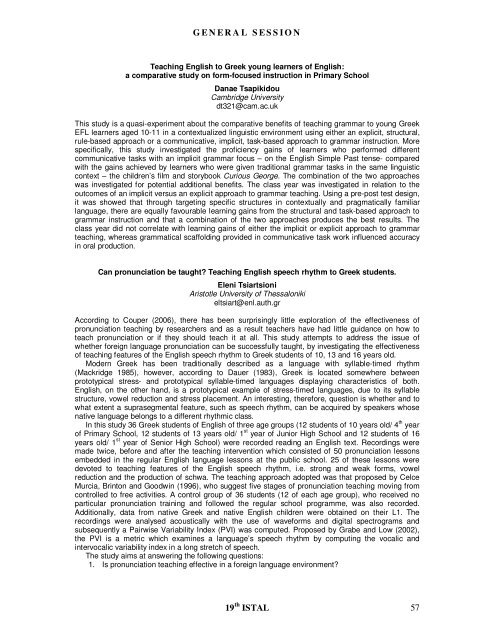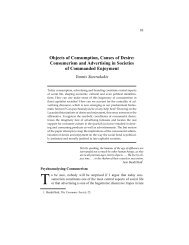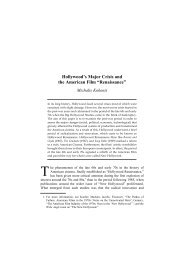19 International Symposium on Theoretical and Applied Linguistics ...
19 International Symposium on Theoretical and Applied Linguistics ...
19 International Symposium on Theoretical and Applied Linguistics ...
Create successful ePaper yourself
Turn your PDF publications into a flip-book with our unique Google optimized e-Paper software.
G E N E R A L S E S S I O N<br />
Teaching English to Greek young learners of English:<br />
a comparative study <strong>on</strong> form-focused instructi<strong>on</strong> in Primary School<br />
Danae Tsapikidou<br />
Cambridge University<br />
dt321@cam.ac.uk<br />
This study is a quasi-experiment about the comparative benefits of teaching grammar to young Greek<br />
EFL learners aged 10-11 in a c<strong>on</strong>textualized linguistic envir<strong>on</strong>ment using either an explicit, structural,<br />
rule-based approach or a communicative, implicit, task-based approach to grammar instructi<strong>on</strong>. More<br />
specifically, this study investigated the proficiency gains of learners who performed different<br />
communicative tasks with an implicit grammar focus – <strong>on</strong> the English Simple Past tense- compared<br />
with the gains achieved by learners who were given traditi<strong>on</strong>al grammar tasks in the same linguistic<br />
c<strong>on</strong>text – the children’s film <strong>and</strong> storybook Curious George. The combinati<strong>on</strong> of the two approaches<br />
was investigated for potential additi<strong>on</strong>al benefits. The class year was investigated in relati<strong>on</strong> to the<br />
outcomes of an implicit versus an explicit approach to grammar teaching. Using a pre-post test design,<br />
it was showed that through targeting specific structures in c<strong>on</strong>textually <strong>and</strong> pragmatically familiar<br />
language, there are equally favourable learning gains from the structural <strong>and</strong> task-based approach to<br />
grammar instructi<strong>on</strong> <strong>and</strong> that a combinati<strong>on</strong> of the two approaches produces the best results. The<br />
class year did not correlate with learning gains of either the implicit or explicit approach to grammar<br />
teaching, whereas grammatical scaffolding provided in communicative task work influenced accuracy<br />
in oral producti<strong>on</strong>.<br />
Can pr<strong>on</strong>unciati<strong>on</strong> be taught? Teaching English speech rhythm to Greek students.<br />
Eleni Tsiartsi<strong>on</strong>i<br />
Aristotle University of Thessal<strong>on</strong>iki<br />
eltsiart@enl.auth.gr<br />
According to Couper (2006), there has been surprisingly little explorati<strong>on</strong> of the effectiveness of<br />
pr<strong>on</strong>unciati<strong>on</strong> teaching by researchers <strong>and</strong> as a result teachers have had little guidance <strong>on</strong> how to<br />
teach pr<strong>on</strong>unciati<strong>on</strong> or if they should teach it at all. This study attempts to address the issue of<br />
whether foreign language pr<strong>on</strong>unciati<strong>on</strong> can be successfully taught, by investigating the effectiveness<br />
of teaching features of the English speech rhythm to Greek students of 10, 13 <strong>and</strong> 16 years old.<br />
Modern Greek has been traditi<strong>on</strong>ally described as a language with syllable-timed rhythm<br />
(Mackridge <str<strong>on</strong>g>19</str<strong>on</strong>g>85), however, according to Dauer (<str<strong>on</strong>g>19</str<strong>on</strong>g>83), Greek is located somewhere between<br />
prototypical stress- <strong>and</strong> prototypical syllable-timed languages displaying characteristics of both.<br />
English, <strong>on</strong> the other h<strong>and</strong>, is a prototypical example of stress-timed languages, due to its syllable<br />
structure, vowel reducti<strong>on</strong> <strong>and</strong> stress placement. An interesting, therefore, questi<strong>on</strong> is whether <strong>and</strong> to<br />
what extent a suprasegmental feature, such as speech rhythm, can be acquired by speakers whose<br />
native language bel<strong>on</strong>gs to a different rhythmic class.<br />
In this study 36 Greek students of English of three age groups (12 students of 10 years old/ 4 th year<br />
of Primary School, 12 students of 13 years old/ 1 st year of Junior High School <strong>and</strong> 12 students of 16<br />
years old/ 1 st year of Senior High School) were recorded reading an English text. Recordings were<br />
made twice, before <strong>and</strong> after the teaching interventi<strong>on</strong> which c<strong>on</strong>sisted of 50 pr<strong>on</strong>unciati<strong>on</strong> less<strong>on</strong>s<br />
embedded in the regular English language less<strong>on</strong>s at the public school. 25 of these less<strong>on</strong>s were<br />
devoted to teaching features of the English speech rhythm, i.e. str<strong>on</strong>g <strong>and</strong> weak forms, vowel<br />
reducti<strong>on</strong> <strong>and</strong> the producti<strong>on</strong> of schwa. The teaching approach adopted was that proposed by Celce<br />
Murcia, Brintοn <strong>and</strong> Goodwin (<str<strong>on</strong>g>19</str<strong>on</strong>g>96), who suggest five stages of pr<strong>on</strong>unciati<strong>on</strong> teaching moving from<br />
c<strong>on</strong>trolled to free activities. A c<strong>on</strong>trol group of 36 students (12 of each age group), who received no<br />
particular pr<strong>on</strong>unciati<strong>on</strong> training <strong>and</strong> followed the regular school programme, was also recorded.<br />
Additi<strong>on</strong>ally, data from native Greek <strong>and</strong> native English children were obtained <strong>on</strong> their L1. The<br />
recordings were analysed acoustically with the use of waveforms <strong>and</strong> digital spectrograms <strong>and</strong><br />
subsequently a Pairwise Variability Index (PVI) was computed. Proposed by Grabe <strong>and</strong> Low (2002),<br />
the PVI is a metric which examines a language’s speech rhythm by computing the vocalic <strong>and</strong><br />
intervocalic variability index in a l<strong>on</strong>g stretch of speech.<br />
The study aims at answering the following questi<strong>on</strong>s:<br />
1. Is pr<strong>on</strong>unciati<strong>on</strong> teaching effective in a foreign language envir<strong>on</strong>ment?<br />
<str<strong>on</strong>g>19</str<strong>on</strong>g> th ISTAL 57






